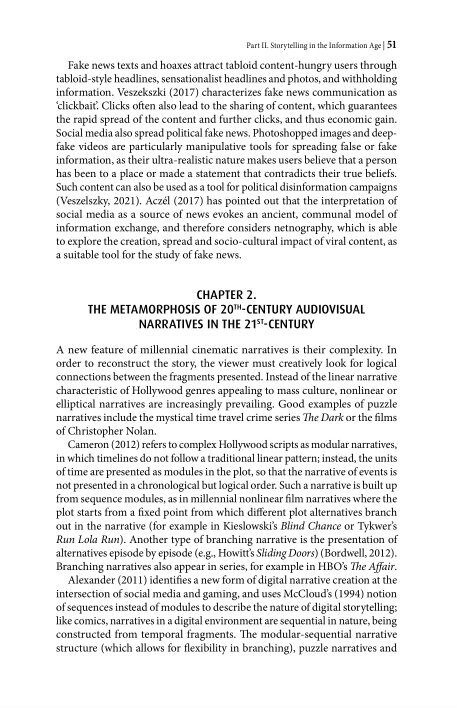

OCR
Part II. Storytelling in the Information Age ] 51 Fake news texts and hoaxes attract tabloid content-hungry users through tabloid-style headlines, sensationalist headlines and photos, and withholding information. Veszekszki (2017) characterizes fake news communication as ‘clickbait. Clicks often also lead to the sharing of content, which guarantees the rapid spread of the content and further clicks, and thus economic gain. Social media also spread political fake news. Photoshopped images and deepfake videos are particularly manipulative tools for spreading false or fake information, as their ultra-realistic nature makes users believe that a person has been to a place or made a statement that contradicts their true beliefs. Such content can also be used as a tool for political disinformation campaigns (Veszelszky, 2021). Aczél (2017) has pointed out that the interpretation of social media as a source of news evokes an ancient, communal model of information exchange, and therefore considers netnography, which is able to explore the creation, spread and socio-cultural impact of viral content, as a suitable tool for the study of fake news. CHAPTER 2. THE METAMORPHOSIS OF 20™-CENTURY AUDIOVISUAL NARRATIVES IN THE 21°'-CENTURY A new feature of millennial cinematic narratives is their complexity. In order to reconstruct the story, the viewer must creatively look for logical connections between the fragments presented. Instead of the linear narrative characteristic of Hollywood genres appealing to mass culture, nonlinear or elliptical narratives are increasingly prevailing. Good examples of puzzle narratives include the mystical time travel crime series The Dark or the films of Christopher Nolan. Cameron (2012) refers to complex Hollywood scripts as modular narratives, in which timelines do not follow a traditional linear pattern; instead, the units of time are presented as modules in the plot, so that the narrative of events is not presented in a chronological but logical order. Such a narrative is built up from sequence modules, as in millennial nonlinear film narratives where the plot starts from a fixed point from which different plot alternatives branch out in the narrative (for example in Kieslowski’s Blind Chance or Tykwer’s Run Lola Run). Another type of branching narrative is the presentation of alternatives episode by episode (e.g., Howitt’s Sliding Doors) (Bordwell, 2012). Branching narratives also appear in series, for example in HBO’s The Affair. Alexander (2011) identifies a new form of digital narrative creation at the intersection of social media and gaming, and uses McCloud’s (1994) notion of sequences instead of modules to describe the nature of digital storytelling; like comics, narratives in a digital environment are sequential in nature, being constructed from temporal fragments. The modular-sequential narrative structure (which allows for flexibility in branching), puzzle narratives and
Szerkezeti
Custom
Image Metadata
- Kép szélessége
- 1831 px
- Kép magassága
- 2835 px
- Képfelbontás
- 300 px/inch
- Kép eredeti mérete
- 1.31 MB
- Permalinkből jpg
- 022_000040/0051.jpg
- Permalinkből OCR
- 022_000040/0051.ocr
Bejelentkezés
Magyarhu
